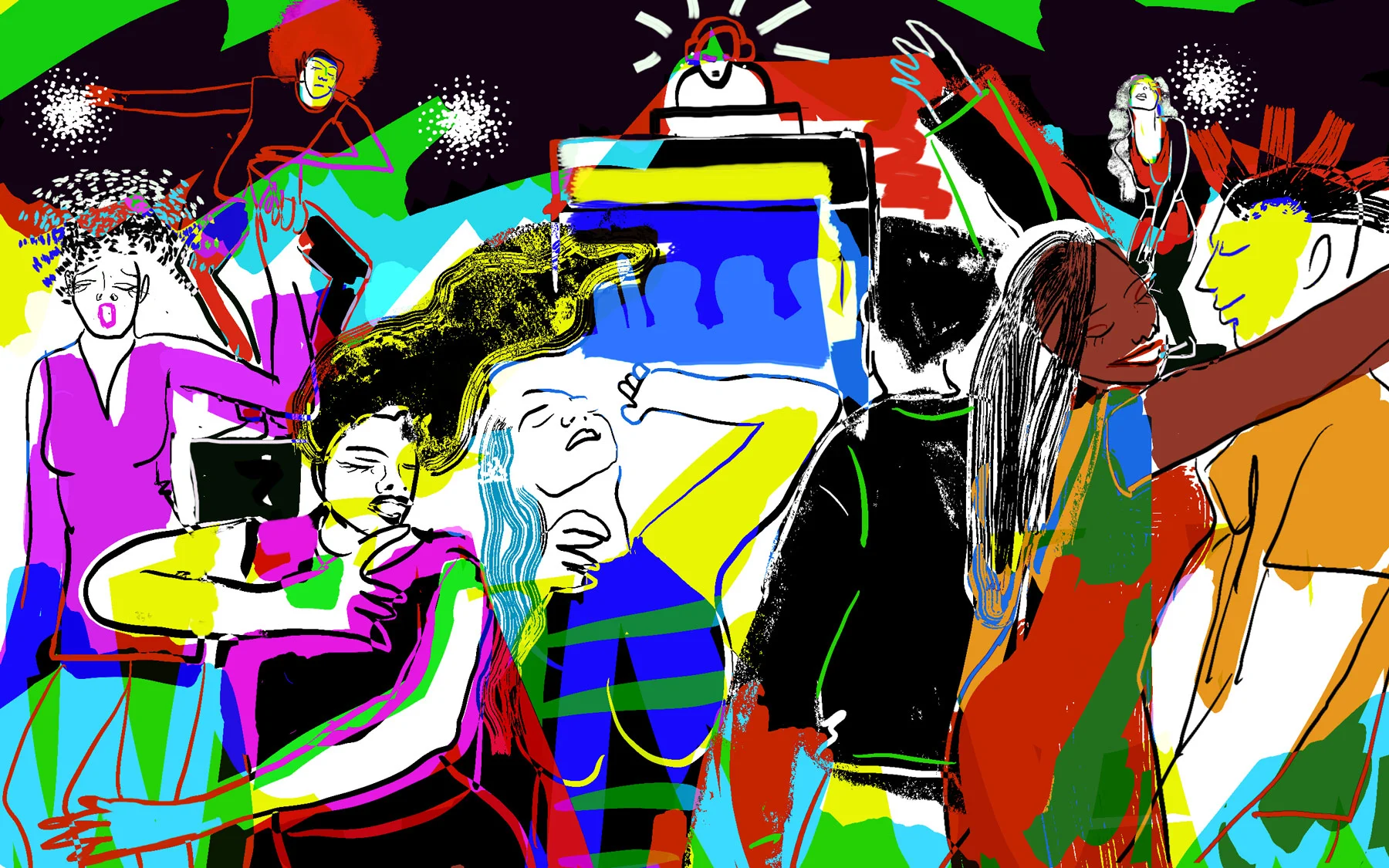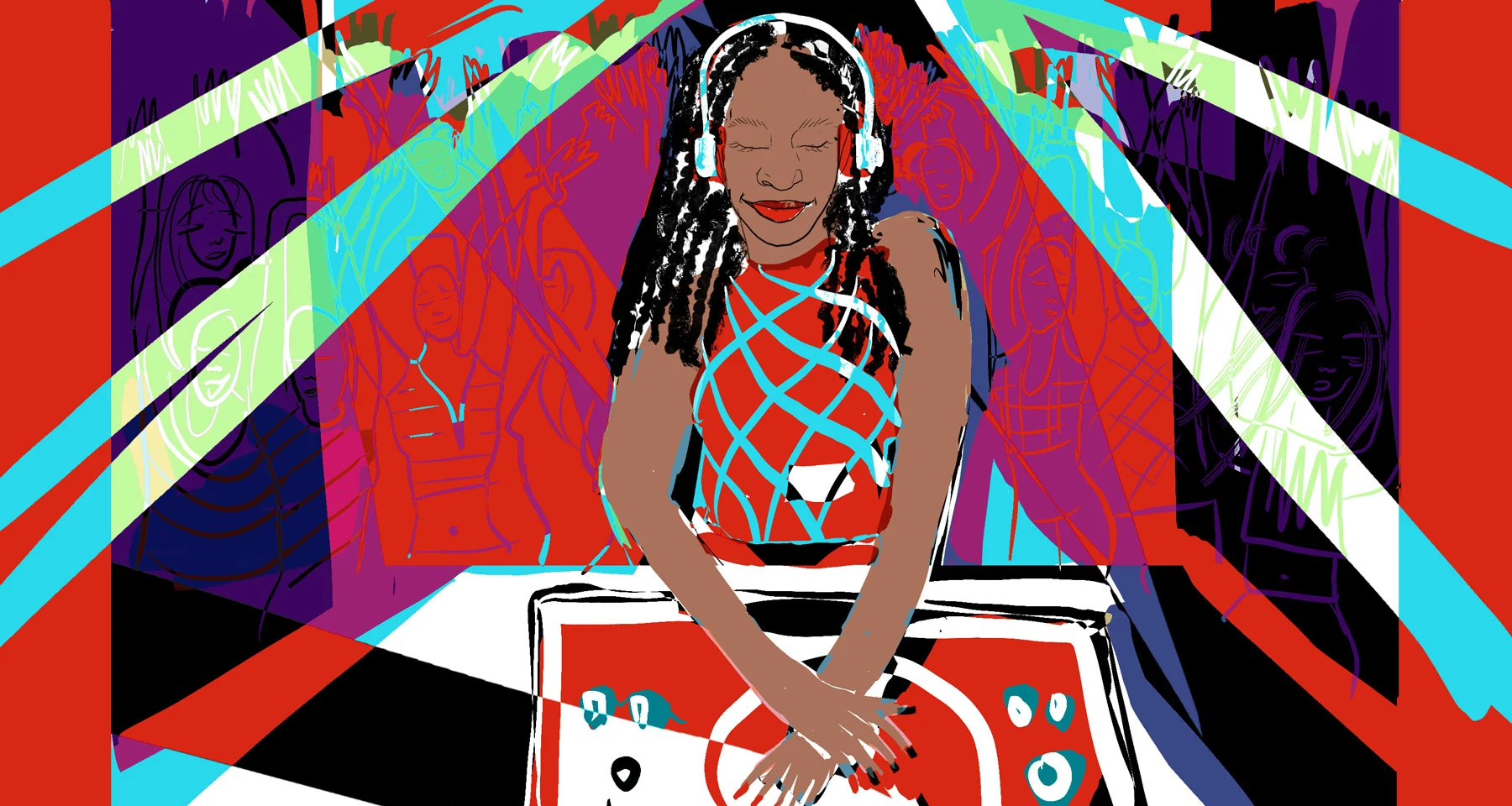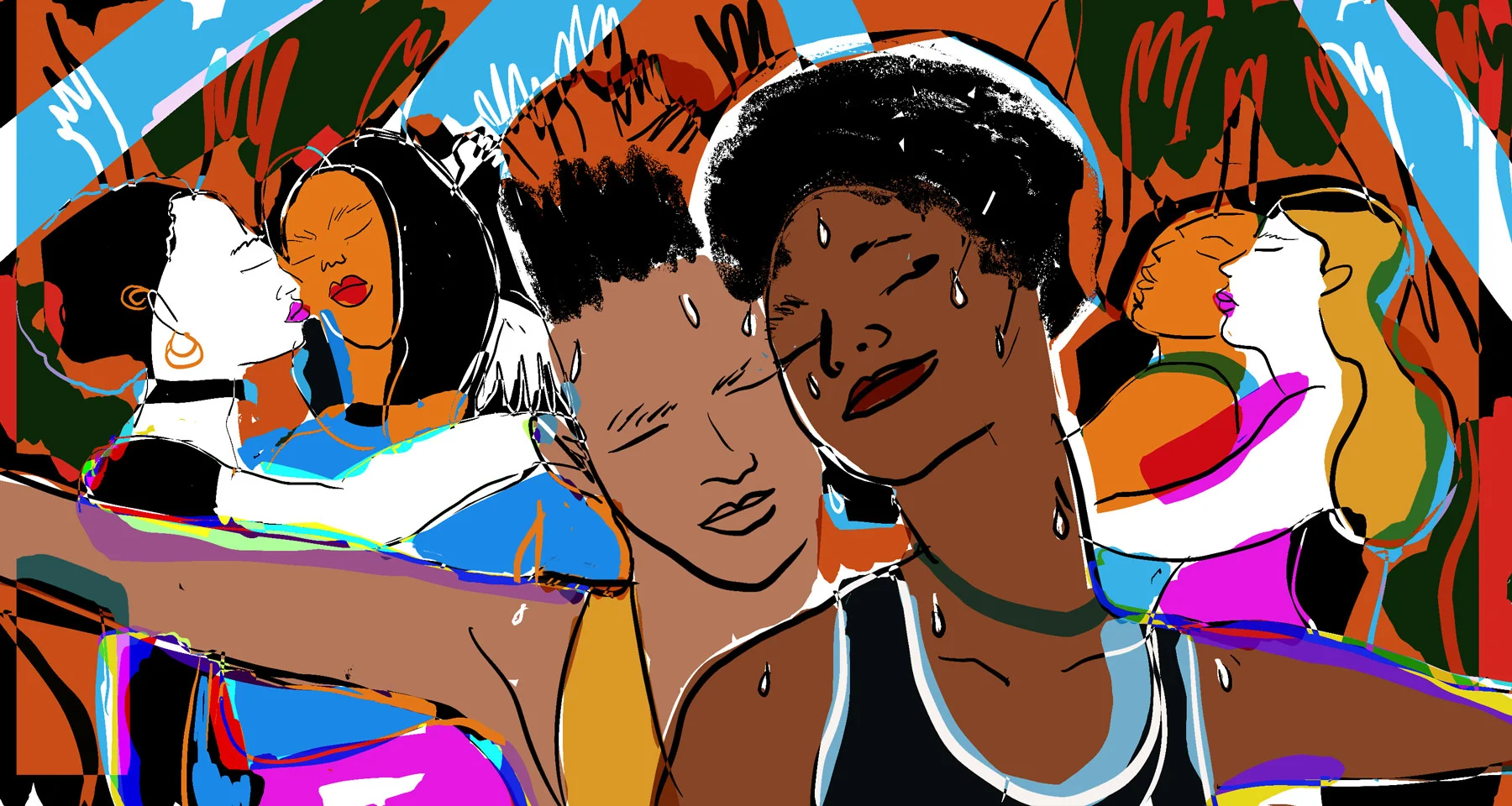

If you’ve been to your fair share of festivals or club nights, chances are you’ll have a few standout memories of the last songs that were played at your favorite ones. From romantic ballads to disco anthems to Motown classics, the last tune ties the night together and leaves you with that lasting high. But how does a DJ harness the power that comes with being behind the decks in that all-important moment as the lights go up and we’re all ushered back into the real world? Alex Kahl asked eight DJs and music experts what the last track means to them, and how they go about selecting the songs that send us home.
Illustrations by Ngadi Smart.
One night in 2016, in a dingy underground basement nightclub in York, England, the final DJ of the night was bringing an end to a long and heavy bassline event. Things were winding down as the venue neared its closing time and people began to head for the doors. Just as we reached the exit, the track finished playing. There was a five-second silence before the unmistakable opening chord progression of Childish Gambino’s Redbone flew around the space, and every person in the building charged back to the dance floor.
Whether it was the sweet, melodic tones of the track cutting through the six hours of 140bpm that had come before it, or simply the fact that it was the zeitgeist song of that winter, I’ve never seen a group of people so utterly euphoric for the duration of a DJ’s last song.

Even if someone has been to tons of events in their time, most people will have that one memory that comes to mind when you ask them about the last song of a night. Like the poetic final sentence in a novel that gives you a fuzzy feeling as you close its wrinkled cover for the last time, the way something ends often defines the feeling it leaves us with.
The beauty of this strange phenomenon of the last song in a set is that each DJ has their own unique way of looking at it. Some see it as a chance to break away from the tone of the night up until then and show something very personal to them, while others focus solely on giving the crowd a moment of spiritual satisfaction and togetherness. Some of them have their last song mapped out before they begin a set, while others will wait and see how the night progresses before choosing it on the fly.
As you’re about to see, just as most of us have a memory that stands out when we think about the last song of the night, well – the DJs themselves are often no different.

Gilles Peterson is a French-British DJ
“The most memorable moments are reserved for the end of the night. As a DJ, the two best times for me are the beginning and the end. If you’re playing during the peak of the night, it’s like eating the main dish without the appetizer or dessert. For the full experience, you need to stay there for the full session. It’s about being together for the whole happening and feeling the music and atmosphere grow, so that when you get to that final song it’s like the feeling of completing a marathon: relief and spiritual satisfaction!
The final song, for me, needs to be in an odd time signature or in different sections (slow/mid/fast.) Or it’s quite simply the moment to play a slow song. Songs like Minnie Ripperton’s Les Fleurs are absolutely perfect – they reach all those points that make you want to come again, and the version by 4hero starts off like the original but breaks halfway through into 6/8 time signature, and then reverts back to the slow pace for the finale! It’s an absolute winner with hands-in-the air strength.
I played Yussef Lateef’s Like It Is at a big outdoor pool event in Los Angeles, and I remember the rave turning into a scene from Swan Lake – everyone dancing in unison led by what seemed like professional ballet dancers! That was as magnificent a response as I’ve ever had.”
Solomun is a Bosnian-German DJ
Generally speaking, with the last track, you want to live up to the night itself, and all the emotions that have accumulated throughout it.
“When you play a set, you’re telling a story, so you have to think about the final page of the story that you’re slowly building towards. And that last page usually completely determines the feeling that people take with them when leaving the party.
Generally speaking, with the last track, you want to live up to the night itself, and all the emotions that have accumulated throughout it. So, most of the time my last song is generally within the realm of what the night had already promised beforehand.
But then there are those instances where you try a complete break from what’s come before – for example a new wave track from the 80s that still fits into the 4/4 context. Or, in those very rare moments that have become more and more infrequent in recent years, where everything is just right, I would even play Hate It Or Love It by The Game and 50 Cent, or The Power of Love by Frankie Goes to Hollywood.
For me to play something so out of the ordinary is pretty rare. If you’re in a small club, it’s a late night and you’ve spent a few hours playing, you’ve created momentum with the crowd and the whole room has melted into one. Only then can you take the full risk and almost play any genre you want as a final track, even if it’s completely unexpected and breaks away from everything that’s happened before it, even hip hop or funk – or something slightly cheesy. You’ve been playing house and techno all night before that, so this break can actually work. And you hope it’s something the crowd will remember for a while, and that it becomes a memory they can cherish.”

Krystal Klear is a DJ from Ireland
The glimmering lights hit the mirror ball and everyone slow danced like it was prom night.
“The last song can often be the most important for the audience. It leaves a lasting memory of the night and can send them home with good energy, so it’s important to give it some consideration. If the audience and I have connected then I’ll generally go for something very meaningful to me, as I want to share a personal element as the final goodbye to them. If it’s been a really heavy set or a difficult crowd, I might aim for something classic or happy to leave everyone feeling good.
I remember playing a mashup of Metro Area and Kings of Tomorrow at a crowded Panorama Bar. I was feeling super emotional about a lot of stuff that happened in my life at what felt like a full circle moment and I just thought ‘I don’t care if this is super downtempo, I wanna release this feeling and hear this song as who knows when I’ll get the chance to again,’ and the reaction was insane. Look, Kings of Tomorrow is a classic but the Metro Area track underneath is fairly mellow. They’re both beautiful individually, but together, they do so many things for my soul. There was lots of hugging and singing when I played it. Moments like that really stand out.
Life plays a big role in these kinds of things. Without a doubt, one moment that never leaves me was in New York. I ran into an ex who I hadn’t spoken to in a long time. She was never really into dance music but DJ Harvey was playing in Brooklyn. I told her, ‘I know it ain’t your thing and I know we haven’t seen each other in years but if ever there was a chance to hear amazing dance music, it’s now.’ So we went, we danced, we caught up and when the lights came on, Harvey played Bee Gees’ How Deep is Your Love and the second those chords came in, the glimmering lights hit the mirror ball and everyone – including us – slow danced like it was prom night. I guess that last song opened up a feeling that changed two people’s lives in ways we would never have expected. Like I said, the last song always deserves consideration.”
Colleen “Cosmo” Murphy is a DJ from the US
This will be the last song in their head when they go to sleep and the first song that comes to mind the following day.
“The last song of my set is hugely important for me. I nearly always have an idea of which song will start off the set and which song I’d like to end the set with, but of course as a seasoned pro I also have other options just in case the atmosphere isn’t what I had imagined.
Last songs have to be meaningful so the lyrics are very important. This is a moment for people throwing their hands up in abandon, singing along and feeling a spirit of togetherness. It’s a song that people will take home with them as an earworm: the last song in their head when they go to sleep and the first song that comes to mind the following day. Playing the last song isn’t a time to be clever and to flash your trainspotter credentials by picking that obscure record that was released in 1983 but nobody really cared about at the time to prove what a great digger you are. It’s also not the time to break a new record nobody has heard before, although a current favorite can work.
This is the song that’s not only the final musical ’statement,’ but also the DJ’s last chance to raise the energy level of everybody on the dance floor so they can bring a positive feeling of collectivity back out into the world. Music can make the world a better place.
One of my personal favorite last songs is Stevie Wonder’s As because nearly everybody knows it (not only Stevie Wonder fans.) The musicianship is inspired and the lyrics are an ode to eternal, unconditional love.”

Shiba Melissa Mazaza is a British-Malawian music journalist, curator and DJ based in South Africa
“Years ago, I was taught that a DJ set is a journey, a story. So it makes sense to me to see the last song as unique and representative of you and your character, a signature of sorts. I want to leave remembering a DJ. I want to feel like I understand why they love music as a means of connecting with others. I want to see how they share their platform with the next act, and how they segue to the next chapter. Of course, not every story has a happy ending, but whatever your final flourish is, make it your best, do it sincerely and make it yours.
The last set I played before Covid-19 hit was at a bar on Long Street in the city, and it was pivotal to where I am today. Akuvi, a friend from Norway, was performing that night and she asked me to play Afrobeats while opening for her. I decided to bring some Amapiano too, just in case. It was the first time I had ever played Amapiano for an audience, and I didn’t expect the reaction it received. I was nervous because, as a Malawian person born in the UK, I couldn’t understand the vernacular and I felt separated from the people who created it because of that. Amapiano hadn’t quite escalated to what it is now in Cape Town and was still considered ‘too ratchet’ or just ‘for the lower classes.’ There’s something that comes over you when this kind of music is in your hands and you can feel everyone getting lost in it. It’s indescribable. Around closing time I finished the set with a song called Uvalo by Aymos, Kabza de Small and DJ Maphorisa, which I was used to enjoying alone in the shower at home or in my own head. The lyrics go ‘Anginavalo, anginavalo’ which means ‘I'm not afraid’ and ‘ngowami wedwa’ as in ‘this is mine.’ And suddenly I wasn’t afraid and I wasn’t alone in my admiration for the sound. Amapiano became an us thing, as different as we all were in that space. I think we all knew at that moment that this genre would change everything we knew about local music and how far it could reach.”
DJ Holographic is a DJ born and raised in Detroit
“I’ve been DJing for 11 years and I’ve never actually prepared a song to end the night with. I’ve thought about it and I know friends who do it, but my philosophy is to let the crowd choose the last song. We choose it together.
I always feel like maybe the crowd magically knows that they chose the last song, that they were able to provide the energy for me to select that tune and that we did it together. It always feels like we’re having a conversation, and they deserve this last song because they were able to keep up with the conversation the whole time.
I really feel that a set needs to tell a story and take people on a journey. It’s not just about getting people as hyped up as you can; it’s a journey that nobody should want to end. You can have a plan for the end of that story, but plans might fail. When you stay on the journey and stay present, the universe just picks the song for you.
When I do try to think about it, it’s always something so cheesy or so out of place. I’m a hopeless romantic so I’d be playing Billy Paul’s Me and Mrs. Jones or some Barry White. Although, just because I go with the flow doesn’t mean I won’t play some Luther Vandross at the very end if that’s the song it’s meant to be.
Don’t get me wrong, when I’m watching a DJ I’m always excited to find out what their last song is, but it’s not something I wait for. For me, it’s the whole journey and what the experience has been like from the start. If I’m listening to you play, I wanna know if I’m going on a rollercoaster, or if I’m just cruising with you in a Cadillac. I wanna know if we’re going on a rocket ship or if you’re giving me a tour of your mind or your soul. I want to be on that journey with you.”

Felipe Maia is a journalist, ethnomusicologist and DJ from Brazil
“It might be a wrap-up track, one that can bring the whole idea behind the set into a handful of bars and thumps, or a cathartic song – I like these the most. Unlike live concerts, where the performers usually follow a pre-set tracklist on stage, there’s a very fluid question-response game played by DJs and the crowd throughout a live performance. The DJs I admire the most are the ones who manage to have a few track-clusters – let’s say three or four tracks that work well together in a sequence – but also know how to pave different routes along the music journey they want to deliver. I really enjoy seeing how the artist behind the decks navigates such a fluid atmosphere on a dance floor. I’m thinking of a track that fills a dance floor and invites every person on it to enjoy the last minutes of blasting noise through the speakers. It could be a pop song – one that people sing out loud – or it could be a B-side that’s rarely seen, or a skillful blend made on the fly. It gathers everyone together, and you’ll hear people shouting, hands and arms touching, feet stomping and everyone pulsating to the track.
I remember seeing Theo Parrish play at Sónar Barcelona in 2019, and that set always comes to mind when I think of great closing tracks. He only used two pickups and his mixer, and it was like watching a sculptor playing around with frequencies. As his last tune played, he waited until the perfect moment to turn the bass all the way up and bring all the crowd together when the kick dropped in.”
Carista is a DJ from Utrecht in The Netherlands
“This is different every single time I’m playing, because for me a DJ set is a journey. You develop a sixth sense, where you try to find a balance in the crowd’s needs and your own. It also depends on what time I’m playing at.
Never Too Much by Luther Vandross is one of my all-time favorites. It has a nostalgic warmth to it that’s so full of love and brings big smiles to people’s faces. I just want people to be smiling when they leave the dance floor, so I try to find a song that does have a positive message but hides it in a nice melody. The kind of song people might look for when they get home. When I played Never Too Much at Filmcafé in Utrecht a few months ago everybody was standing on their chairs even though they weren’t allowed to dance at all.
Scan 7’s Resistance is a track I played recently to end my closing set at Lofi in Amsterdam. This song starts with a message: ‘If you can hear this, you are part of the resistance.’ It’s a perfect example of a track that has a ‘hidden’ message about society but still has that nostalgic feel to it because of the grand string orchestra that takes you on a journey.”

